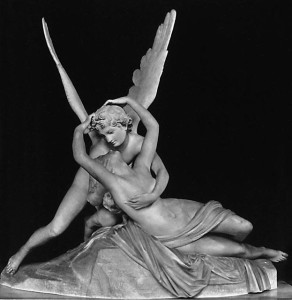
We are always looking for reminders of some of the wonderful stories and sights to illuminate the history of the Golden Triangle. As we mentioned in our post about Erickson Monuments, there was a wonderful statue in their Speer facing window. Many of you will remember the late Gene Amole as an announcer on KVOD (now Colorado Public Radio) and a columnist for The Denver Post. He discussed this very statue in his June 16, 1992, Denver Post column (excerpted from Amole’s book, One More Time).
Naked lovers go to a new window: The Kiss
Have you been wondering what happened to the erotic statue of Cupid and Psyche that used to stop traffic at 920 Speer Blvd in Denver? Psyche was lounging back in Cupid’s arms. He is kneeling behind her with his left arm cradling her bosom. Her arms are extended above her with her hands on his head as he is about to kiss her. Both are naked as jaybirds. The figures are about half life-size.
For years it was displayed in the front window of Erickson Monuments and was illuminated at night. It was the subject of columns in the Rocky Mountain News by Molly Mayfield and Lee Casey. One man and woman even thought of using it as a grave marker when they died but decided it might be inappropriate.
The original Cupid and Psyche by Antonio Canova belongs to the Louvre Museum in Paris. Like the original, the Denver version is sculpted from Carrara marble, the same marble Michelangelo used in his sculpture. The models were Napoleon’s sister, Pauline Bonaparte, and a friend. “A rather close friend,” Molly Mayfield observed in her column.
The copy was donated to the Denver Art Museum by the Phipps family. It was sold in 1939 to Erickson Monuments “just for cartage costs,” according to Julie Hendee, the daughter of Roy Erickson, who with his brother, Milton, inherited the company from their father, Carl Erickson. Hendee now operates Erickson’s Monuments with her husband, David.
Otto Karl Bach, then director of the Denver Art Museum, snorted, “Degenerate Hellenism!… Canova rated pretty high at the beginning of the 19th century and during the era that enjoyed iron deer on front lawns, but he was a weak classicist.”
But was he? Robert Hughes, reviewing the Antonio Canova exhibit at the Museo Correr in Venice for the current edition of Time Magazine writes “Long out of fashion and hard to love, Canova was nevertheless a spectacularly gifted sculptor.
“Amor and Psyche is the masterpiece of Canova’s ‘graceful’ style – and by any standards, one of the most spectacular technical tours of force in the history of stone carving… Here, the empty spaces, the holes in the white love knot of figures are as interesting as the limbs, bodies and heads.”
The Metropolitan Museum of Art in New York makes do with a plaster model for its collection. The Denver marble statue is almost identical with the original except, “the draping on Psyche’s thigh is a bit more revealing on the original,” Hendee said.
According to Greek mythology, Venus was jealous of Psyche’s beauty and ordered her son, Cupid, to kill her. But he fell in love with Psyche instead. They were separated, and when Cupid finally found her asleep beside a road, he gave her the kiss Canova immortalized in stone.
In 1983, Erickson’s moved from Speer Boulevard to 1245 Quivas St, off West 13th Avenue in Denver. You can see Cupid and Psyche in their famous embrace there. Milton Erickson designed the Cranmer Park sundial. The company is one of only 50 members in North America of the American Institute of Commemorative Art.
Roy Erickson, who died in 1986, was a friend of mine. When the statue was displayed on Speer Boulevard, he rigged up a hidden microphone in the bushes so he could hear comments of pedestrians. His favorite was from two little boys who stopped to look. After awhile, one lad observed, “He don’t have any pants on.” The other boy was silent for a moment and finally said, “She don’t either.”
This is excerpted from Gene Amole’s book One More Time, June 16, 1992. The book is available for purchase online at Google Books.
